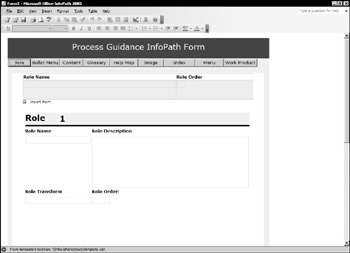Customization Tools
A variety of file types are included in your process template, including HTML, XSL, and XML. There are also a variety of tools you can use to customize these files:
-
XML/XSL editors
-
Microsoft InfoPath 2003
-
MSF HTML Build Utility
-
Third-party tools
The following subsections describe the features and functions of each of these tools.
XML/XSL editors
The process guidance portion of the template contains several XML and XSL files, especially in the \Windows SharePoint Services\Process Guidance\Supporting Files\XSLs or the \Windows SharePoint Services\Process Guidance\Supporting Files\XML directories. Visual Studio 2005 has a built-in XML editor. You can also use Notepad, Wordpad, or third-party solutions.
Microsoft InfoPath 2003
Microsoft InfoPath is a useful tool for editing the process guidance portion of your process templates. It is available in Microsoft Office 2003 and is primarily used to edit and validate .xsd and .xsn documents. However, you can incorporate XML files by creating a new form and using an XML document or schema as your data source.
| Important | You must completely exit InfoPath before trying to render your process guidance files in the browser. By default, InfoPath will place a file lock on open documents and prevent you from looking at your updates. |
You can also use the default InfoPath template file located at the following location:
\Windows Sharepoint Services\Process Guidance\Supporting Files\XML\template.xsn
Figure 22-1 shows a screenshot of template.xsn edited in the InfoPath tool.
InfoPath can manage several file types included in Table 22-1.
| File Extension | Description |
|---|---|
| .xml | Extensible Markup Language file |
| .xsd | XML Schema Definition file |
| .xsf | InfoPath Manifest file |
| .xsl | Extensible Stylesheet Language Template file |
| .xsn | InfoPath Form Template file |
InfoPath is designed to facilitate the process of creating and filling out forms. It has two specific modes to match up with these tasks: form filling and design mode. The form-filling mode was designed to prevent casual users from changing the schema. As opposed to a tool like Wordpad, InfoPath can validate your schema and ensure that it is well formed.

Figure 22-1
| Important | We highly recommend that you install InfoPath 2003 Service Pack 1 before attempting to edit your process guidance files. |
MSF HTML Build utility
The MSFWinBuild tool is used to compile your process guidance from XML to HTML pages. This compilation process is necessary for performance and zone security reasons. You can download the tool at the following link (the documentation is included):
http://www.gotdotnet.com/workspaces/workspace.aspx?id=
Please refer to the MSDN help file (http://www.msdn.microsoft.com) for more detailed information on how to compile your process guidance files using the tool.
Third-party tools
At the time of writing, a few preliminary process template–related offerings are on the market:
-
Joel Semeniuk, a Canadian Microsoft Regional Director, has released a process template editor on GotDotNet dubbed the "VSTS Customization Toolkit." Please note that at the time of writing, this toolkit is still in pre-release stages and should not be run or installed on a production system. Please visit http://www.GotDotNet.com or Joel's weblog for more details: http://www.weblogs.asp.net/Jsemeniuk/.
-
Brightworks has several commercial MSF management tools for SharePoint. You can learn more about them at http://www.brightworks.com.
-
Osellus, Inc., has released a commercial VSTS process template editor called the IRIS Process Author that is available as a standalone tool and as a software-as-service. Check out the following website for details: http://www.osellus.com.
EAN: 2147483647
Pages: 220